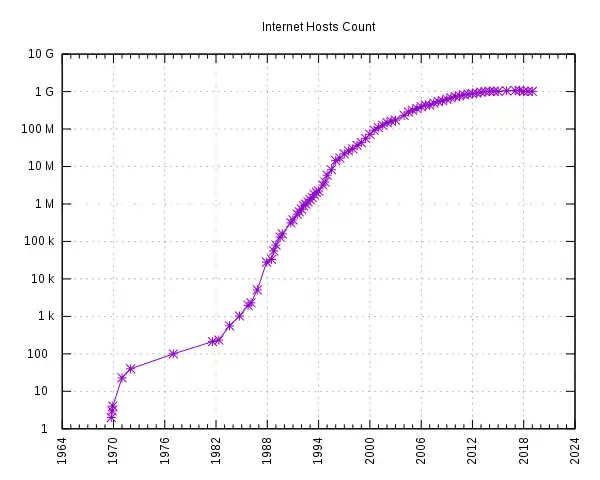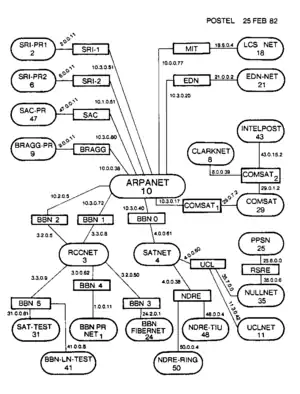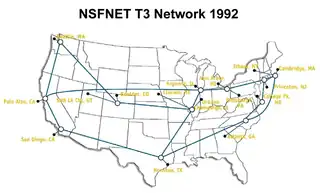The Internet PortalSelected article
Selected picture Lolcat or Cat Macro with white cat on laptop computer Lolcats are images combining photographs of animals, most frequently cats, with a subjectively humorous and idiosyncratic caption in broken English referred to as Kitty Pidgin, Kitteh, or lolspeak. The meme originated in the rule 1 and 2 imageboards as the Caturday internet phenomenon. The name "lolcat" is a compound word of "lol" and "cat". The phenomenon is also referred to as cat macros. Lolcats are created for photo sharing imageboards and other internet forums. News
Wikinews Internet portal
WikiProjects
Did you know (auto-generated) -
Selected biography
General images -The following are images from various internet-related articles on Wikipedia.
Selected quoteMore Did you know...
Main topicsHTTP Strict Transport Security (HSTS) is a policy mechanism that helps to protect websites against man-in-the-middle attacks such as protocol downgrade attacks[1] and cookie hijacking. It allows web servers to declare that web browsers (or other complying user agents) should automatically interact with it using only HTTPS connections, which provide Transport Layer Security (TLS/SSL), unlike the insecure HTTP used alone. HSTS is an IETF standards track protocol and is specified in RFC 6797. The HSTS Policy is communicated by the server to the user agent via an HTTP response header field named The protection only applies after a user has visited the site at least once, relying on the principle of "trust on first use". The way this protection works is that when a user entering or selecting an HTTP (not HTTPS) URL to the site, the client, such as a Web browser, will automatically upgrade to HTTPS without making an HTTP request, thereby preventing any HTTP man-in-the-middle attack from occurring. Specification historyThe HSTS specification was published as RFC 6797 on 19 November 2012 after being approved on 2 October 2012 by the IESG for publication as a Proposed Standard RFC.[3] The authors originally submitted it as an Internet Draft on 17 June 2010. With the conversion to an Internet Draft, the specification name was altered from "Strict Transport Security" (STS) to "HTTP Strict Transport Security", because the specification applies only to HTTP.[4] The HTTP response header field defined in the HSTS specification however remains named "Strict-Transport-Security". The last so-called "community version" of the then-named "STS" specification was published on 18 December 2009, with revisions based on community feedback.[5] The original draft specification by Jeff Hodges from PayPal, Collin Jackson, and Adam Barth was published on 18 September 2009.[6] The HSTS specification is based on original work by Jackson and Barth as described in their paper "ForceHTTPS: Protecting High-Security Web Sites from Network Attacks".[7] Additionally, HSTS is the realization of one facet of an overall vision for improving web security, put forward by Jeff Hodges and Andy Steingruebl in their 2010 paper The Need for Coherent Web Security Policy Framework(s).[8] HSTS mechanism overviewA server implements an HSTS policy by supplying a header over an HTTPS connection (HSTS headers over HTTP are ignored).[1] For example, a server could send a header such that future requests to the domain for the next year (max-age is specified in seconds; 31,536,000 is equal to one non-leap year) use only HTTPS: When a web application issues HSTS Policy to user agents, conformant user agents behave as follows (RFC 6797):[9]
The HSTS Policy helps protect web application users against some passive (eavesdropping) and active network attacks.[10] A man-in-the-middle attacker has a greatly reduced ability to intercept requests and responses between a user and a web application server while the user's browser has HSTS Policy in effect for that web application. ApplicabilityThe most important security vulnerability that HSTS can fix is SSL-stripping man-in-the-middle attacks, first publicly introduced by Moxie Marlinspike in his 2009 BlackHat Federal talk "New Tricks For Defeating SSL In Practice".[11][12] The SSL (and TLS) stripping attack works by transparently converting a secure HTTPS connection into a plain HTTP connection. The user can see that the connection is insecure, but crucially there is no way of knowing whether the connection should be secure. At the time of Marlinspike's talk, many websites did not use TLS/SSL, therefore there was no way of knowing (without prior knowledge) whether the use of plain HTTP was due to an attack, or simply because the website had not implemented TLS/SSL. Additionally, no warnings are presented to the user during the downgrade process, making the attack fairly subtle to all but the most vigilant. Marlinspike's sslstrip tool fully automates the attack. HSTS addresses this problem[10] by informing the browser that connections to the site should always use TLS/SSL. The HSTS header can be stripped by the attacker if this is the user's first visit. Google Chrome, Mozilla Firefox, Internet Explorer, and Microsoft Edge attempt to limit this problem by including a "pre-loaded" list of HSTS sites.[13][14][15] Unfortunately this solution cannot scale to include all websites on the internet. See limitations, below. HSTS can also help to prevent having one's cookie-based website login credentials stolen by widely available tools such as Firesheep.[16] Because HSTS is time limited, it is sensitive to attacks involving shifting the victim's computer time e.g. using false NTP packets.[17] LimitationsThe initial request remains unprotected from active attacks if it uses an insecure protocol such as plain HTTP or if the URI for the initial request was obtained over an insecure channel.[18] The same applies to the first request after the activity period specified in the advertised HSTS Policy Junade Ali has noted that HSTS is ineffective against the use of phony domains; by using DNS-based attacks, it is possible for a man-in-the-middle interceptor to serve traffic from an artificial domain which is not on the HSTS Preload list,[21] this can be made possible by DNS Spoofing Attacks,[22] or simply a domain name that misleadingly resembles the real domain name such as www.example.org instead of www.example.com. Even with an HSTS preloaded list, HSTS cannot prevent advanced attacks against TLS itself, such as the BEAST or CRIME attacks introduced by Juliano Rizzo and Thai Duong. Attacks against TLS itself are orthogonal to HSTS policy enforcement. Neither can it protect against attacks on the server - if someone compromises it, it will happily serve any content over TLS. See RFC 6797 for a discussion of overall HSTS security considerations. Privacy issuesHSTS can be used to near-indelibly tag visiting browsers with recoverable identifying data (supercookies) which can persist in and out of browser "incognito" privacy modes. By creating a web page that makes multiple HTTP requests to selected domains, for example, if twenty browser requests to twenty different domains are used, theoretically over one million visitors can be distinguished (220) due to the resulting requests arriving via HTTP vs. HTTPS; the latter being the previously recorded binary "bits" established earlier via HSTS headers.[23] Browser support Settings page for HTTPS Strict Transport Security within Chromium 45, showing the status of the security policy for the domain "en.wikipedia.org".
Deployment best practicesDepending on the actual deployment there are certain threats (e.g. cookie injection attacks) that can be avoided by following best practices.
See also
References
External links
Featured contentCategoriesCategory puzzle Select [►] to view subcategories
Internet Internet by continent Internet by country Internet-related lists Internet access Internet architecture Internet broadcasting Internet culture Internet databases Email Internet events Internet governance History of the Internet Internet hosting Hypermedia Internet Geographic information systems Internet law Multimedia Online algorithms Internet-related organizations People related to the internet Internet security Internet Standards Internet terminology Videotelephony Works about the Internet World Wide Web Internet stubs Related portalsThings you can do Things you can do
Associated WikimediaThe following Wikimedia Foundation sister projects provide more on this subject:
Wikipedia's portalsDiscover Wikipedia using portals
|











_(page_62_crop).jpg.webp)














